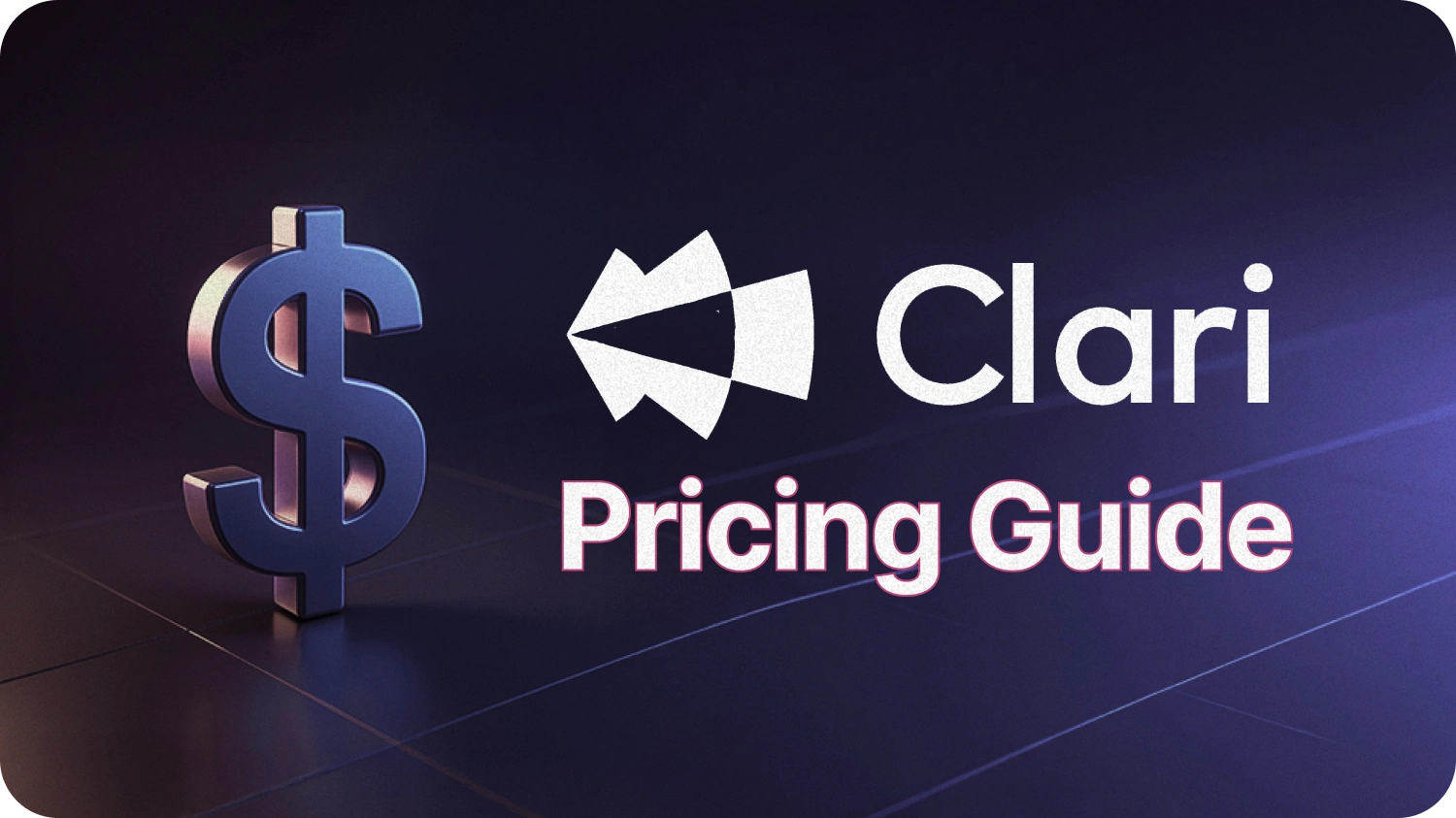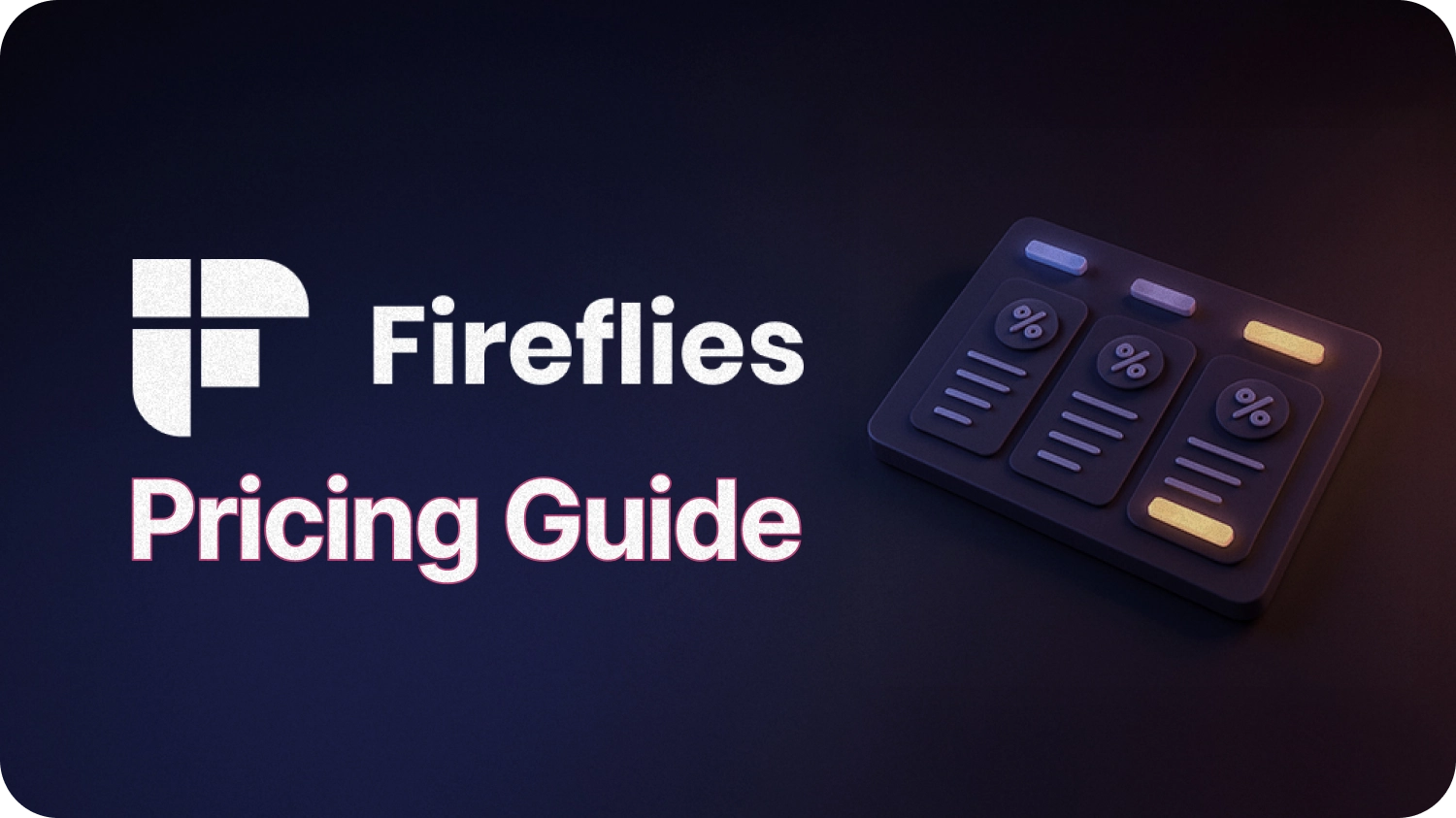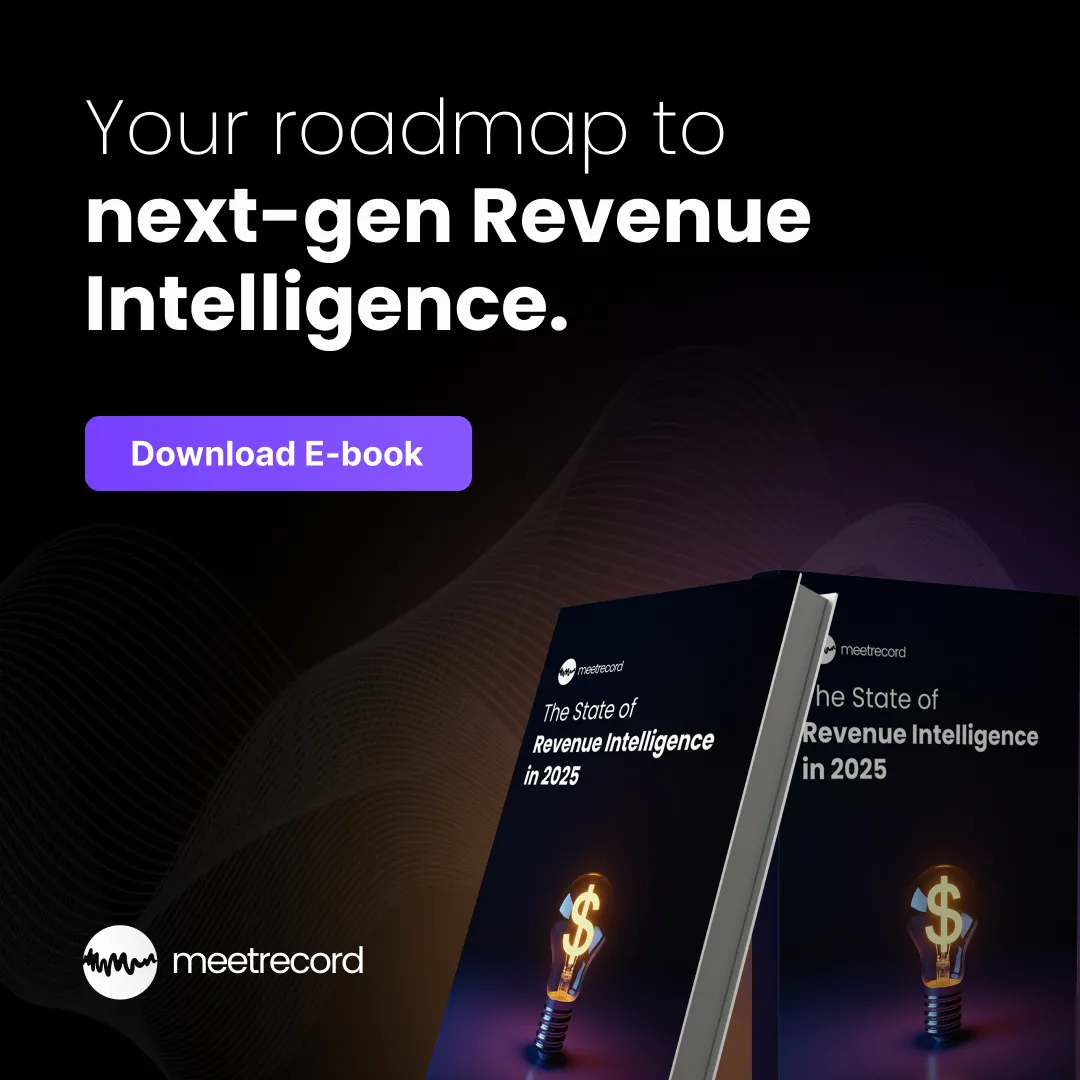Most sales managers treat coaching like a performance review.
And that’s a problem because coaching reps after the call (or, after losing a deal) means you are okay with letting an opportunity slip away.
It’s no surprise 90% of B2B sales training programs fail to impact rep performance. The old way of sales coaching suffers from delayed feedback and lacks context.
Selling in 2025 is a real-time game. Buyers avoid talking to reps when they can, deal cycles are complex and drag forever, and every second in a live conversation counts.
AI-powered, roleplay-based coaching is changing the game because it coaches reps either before a conversation or in real-time while a deal is still on the table.
In this blog, I’ll break down the 10 best real-time sales coaching tools built for today’s selling environment and how to pick the right one for your team.
What is Real-Time Sales Coaching?
Real-time sales coaching isn’t a hypothetical future. It's already changing the way high-performing sales teams win deals in 2025.
Let’s understand what it actually looks like in practice.
How Real-Time Sales Coaching Works
A decade ago, if you wanted to improve a rep’s performance, you’d sit through hours of call recordings, take rigorous notes, then walk them through highlights in a 1:1.
That model assumed every rep needs the same kind of help and that they’ll remember what you said a week later.
Today, AI changes the playing field entirely. With real-time sales coaching software, you can coach your reps during the call, not after. The software listens, understands the context of the conversation, and triggers smart nudges based on what’s actually being said.
Here’s what it typically includes:
1. Live Conversation Intelligence
The AI tracks keywords, intent signals, talk ratios, and even tone. If a rep is missing key discovery questions or pitching the product too hard, the conversation intelligence flags it then and there.
2. Contextual Cues and Call Nudges
Instead of general advice like “ask better questions,” reps get specific prompts such as “ask about budget now” or “mention a success story from a fintech client.”
It’s the kind of coaching that makes a difference mid-call, not after the damage is already done.
3. Roleplay-Based AI Simulations
Some tools, like MeetRecord, take it a step further by letting reps train against AI personas before live calls. Think of it as sparring practice before the real tournament.
Reps can simulate pricing objections, decision-maker resistance, or even ghosting follow-ups, all before they happen for real.
Here’s what MeetRecord’s AI Sales Roleplay looks like. Once you log in to MeetRecord Playground, reps can just hit “Start Call” and interact with the AI buyer persona.
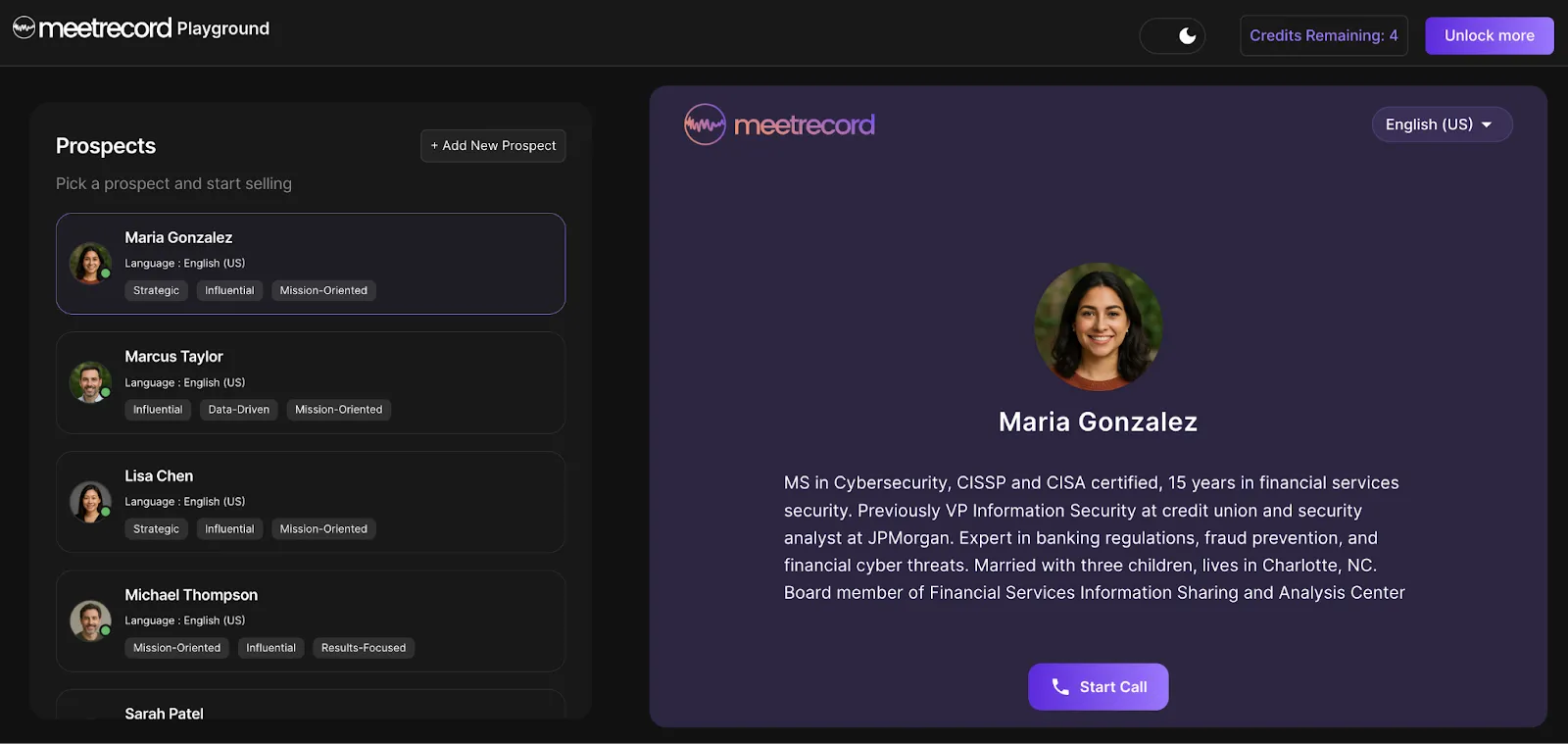
4. Post-Call Feedback Loops
Real-time doesn't replace post-call feedback. The best sales coaching software offers recaps that distil what went well or what didn’t, so reps can apply the learning in the next call.
Real-time sales coaching works because it removes the biggest bottleneck in traditional coaching: time.
Sales managers don’t have the time to review every call. But an AI can listen to all of them, analyze patterns, and intervene at scale.
Real-Time Sales Coaching vs. Traditional Sales Coaching
Traditional sales coaching is like watching game footage after the match is over. You can break down the play, but the opportunity to change the outcome is now gone.
Sadly, most sales teams still operate like this in 2025.
They might use a conversation intelligence software to record calls, maybe tag their peers for review, and then offer their feedback.
But because sales is time-intensive, most coaching feedback is reserved either for the big deals or underperformers. Everyone in between gets left behind.
Real-time coaching fixes these issues. Instead of coaching based on past calls, it coaches based on live context.
You don’t have to wonder if your rep asked about procurement timelines or danced around pricing. You’ll know, because the software flagged it in the moment.
And because the coaching is tailored to what’s happening on the call, reps don’t feel like they’re being micromanaged. They’re being supported.
Here’s the difference between the two coaching models in simple terms:
- Traditional coaching is built on call reviews, spreadsheets, and the manager’s availability.
- Real-time coaching is built on AI, conversation signals, and instant context.
But the biggest shift is in impact.
With real-time coaching, reps improve during deals. Not after they’ve lost three deals in a row.
With traditional coaching, improvement is theoretical. With real-time coaching, it’s practical, immediate, and measurable.
We’re seeing more revenue leaders make this shift not because it’s trendy, but because it works. Real-time tools offer more coaching moments per week, require less admin effort from managers, and help new reps ramp faster.
What are the Benefits of Real-Time Sales Coaching?
Real-time sales coaching gives your reps the help they need while they're selling, not when the deal is already lost.
1. Reps Improve While the Call Is Still Live
Traditional coaching assumes reps can recall key moments from a call days later. They can’t. According to a Gartner study, most sales reps forget up to 70% of their training within just one week.
Real-time coaching solves this by offering real-time nudges, right when they are faced with an objection or the customer name-drops a competitor.
Organizations that provide effective sales coaching improve quota attainment by up to 7%. The keyword here is “effective,” and timely guidance is a big part of that.
2. Managers Get Out of the Weeds
Sales managers spend too much time reviewing calls, prepping coaching notes, or repeating the same feedback to different reps.
This is inefficient and unsustainable, especially if you're managing more than 10 reps or scaling fast.
Real-time sales coaching tools listen to every call, flag moments that matter, and help managers make an impact without burning out.
It doesn’t replace the manager. It just gives them visibility into every conversation without sitting through every minute. That means managers can spend more time on strategy, less on admin.
3. Ramp Time Gets Cut In Half
Yes, new hires can learn by watching recorded calls or shadowing senior AEs.
But they learn better by doing and messing up a little. Real-time coaching gives them a way to learn faster without tanking deals along the way.
Instead of “watch 10 calls and take notes,” reps get live guidance the first time they handle a real objection or miss a key discovery question.
Similarly, AI sales roleplays let rep upskill on their own time in a completely safe environment. That leads to faster confidence and better retention.
4. Coaching Reaches the Middle 70% of Your Team
Most sales orgs focus their efforts on coaching either the top 10% or the bottom 10% of reps. High performers get accolades and more face time, while struggling reps get more 1:1 interventions.
Everyone else is left to figure it out on their own.
Real-time coaching closes that gap. Because AI can take over a large chunk of the coaching responsibility, reps in the “quiet middle” can get the feedback they’ve needed all along.
And that middle 70% is where the biggest revenue lift usually hides.
When done right, real-time coaching sharpens your A players, turns B players into high performers, and exposes the C players who drag down sales productivity.
5. Real-Time Coaching Creates Repeatable Sales Motions
It’s one thing to say your team is following the playbook. It’s another to know they are.
Real-time coaching software reinforces best practices during calls. Whether that’s asking the right discovery questions, following the right talk track, or handling objections the way you’ve trained for—these tools keep everyone aligned to your proven sales process.
This helps reduce the disparity between reps. It also helps you spot what actually works, so you can scale it across the team. It’s the best way to build a sustainable and consistent sales culture.
6. It Reduces Deal Risk Before It Escalates
The best reps know how to spot red flags early: vague timelines, too many stakeholders, and pricing hesitation.
The problem is, not all reps know how to identify these signals or what to do about them.
With real-time coaching, you don’t have to depend on reps to tackle such situations.
The tool flags the risks mid-conversation, suggests reps to ask better follow-ups, or nudges them to clarify the prospects’ decision-making processes. It might even recommend them to pause and change tack.
The result: high likelihood of prospects responding favorably and low risk of deals falling through the cracks.
7. It Makes 1:1s More Focused and Less Repetitive
Ask any manager, and they’ll tell you the same thing: coaching 1:1s often turn into status updates or repeat feedback loops.
Real-time coaching gives both the rep and the manager a shared record of what happened, what was coached, and what still needs work.
Reps can skip the déjà vu and go straight to what matters. They don’t have to bear through “work on your listening” feedback. Instead, they can rely on AI to give them more specific, trackable coaching moments.
This improves the managers’ experience, too. They don’t have to prepare what feedback to offer to each rep. They already have the call summaries to discuss.
8. AI Never Gets Tired (Or Distracted)
Your best coach is your sales manager: on a good day, with enough free time for a 1:1 coaching session, and their full attention on the rep. But let’s be honest: that’s not always possible.
AI-powered coaching doesn’t come with personal baggage, zone out, play favorites, or let a bad morning affect its feedback quality.
It listens to every rep, every time, and applies the same standard of judgment consistently to offer tailored feedback to each of them.
That level of fairness, repetition, and scale is rare in traditional coaching. And it’s what makes real-time sales coaching more effective and sustainable.
What to Look for in Sales Coaching Software?
The best sales coaching tools aren’t just packed with features. They improve rep behavior, manager efficiency, and revenue outcomes without adding complexity to your stack.
Here’s what you should actually evaluate when choosing one.
1. AI Sales Coaching Capabilities
If the AI can’t understand live conversations, contextualize buyer behavior, and offer relevant guidance when it matters, the rest of the product doesn’t matter.
Good AI coaching isn’t about tracking keywords. It helps you recognize patterns.
Can the tool pick up on hesitation around pricing?
Can it flag when a rep talks too much during discovery?
Can it detect deal risks based on sentiment or lack of stakeholder involvement?
These aren’t theoretical asks. McKinsey reports that companies that use AI in their sales processes increase sales by 10% while cutting costs by up to 20%.
If you’re going to invest in AI coaching, make sure it can read between the lines, not just track keywords.
2. Real-Time Call Analysis
Coaching is only useful if it’s timely. If your reps are getting feedback two days after a lost deal, you're not coaching them. You’re running a sales post-mortem.
Look for tools that analyze calls in real time. The best platforms offer suggestions right when the stakes are highest: when a customer brings up objections, expresses urgency, or signals hesitation.
This is how you can save deals from slipping, not in the aftermath of a call.
This capability should include call transcription accuracy, speaker identification, talk-time breakdown, and real-time alerts for deal-critical moments.
The closer the coaching is to the moment, the more likely it sticks.
3. Coaching Insights and Feedback
Vague feedback is the enemy of effective coaching. You can’t tell a rep to “listen more” or “build rapport” unless it’s tied to tangible behavior.
Effective software gives reps clear, specific feedback: what went wrong, why it mattered, and what to try next. Even better if it ties feedback to real calls and patterns across the team.
The right tool will also give managers a structured coaching dashboard. That means AI call scoring, skill ratings, feedback trends, and coaching moments organized by topic.
If a tool just sends you email transcripts and call summaries without actionable insights, you have an AI note-taking tool disguised as coaching software.
4. CRM and Workflow Automation
No one wants to copy-paste feedback between apps. But that’s what happens when a coaching software doesn’t play well with other tools in your sales tech stack.
If your coaching software doesn’t talk to your CRM or LMS, congratulations—you have additional admin tasks to take care of.
You want a tool that integrates directly into where your team already works: Salesforce, HubSpot, Slack, Google Calendar, even tools like Notion or ClickUp.
It should push call notes, highlight follow-ups, and log coaching tasks without manual effort.
Bonus if it can auto-update CRM fields based on what’s said in a call. That saves reps’ time and improves data hygiene, both of which impact forecast accuracy and pipeline review.
If you're curious what automated workflows look like in action, check out these CRM automation examples.
5. Analytics and Progress Tracking
If you’re not measuring the impact of coaching, you’re just taking shots in the dark.
Every sales coaching platform should show you how coaching connects to outcomes. That means:
- Changes in rep behavior over time
- Correlation between coaching and win rates
- Progress by skill or conversation type
- Manager coaching frequency and coverage
Coaching isn’t always about holding reps accountable. Rather, it should be mapped to performance metrics and revenue outcomes.
Make sure the tool of your choice offers benchmarks such as how your reps compare across teams, cohorts, and time periods.
7. Ease of Use and Onboarding Time
We all know about sales tools that have the best marketing and are category leaders in G2. And yet, it takes eight weeks just for reps to get up to speed.
Choose a tool that fits your team’s existing workflow. It should be easy enough for users to start using it on their own, or take less than a week to onboard new users.
The UI should feel modern, frictionless, and rep-friendly. Look for tools that support:
- Single sign-on
- Calendar and meeting sync
- In-app coaching prompts with zero setup
Ask how long it takes to see time-to-value. If the vendor can’t give you a 14-day plan for impact, that’s a red flag.
Ease of use also affects manager adoption. The biggest barrier to software adoption isn’t always a lack of features, but the complexity around using it.
Make sure your coaching tool helps your team sell, not slow them down.
10 Best Real-Time Sales Coaching Platforms (2025)
In 2025, real-time sales coaching has moved from nice-to-have to must-have. The platforms below don’t just record calls. They coach reps in the moment, improve their behavior while deals are still on the line.
1. MeetRecord
MeetRecord is a revenue AI platform built for coaching-led sales orgs. It goes beyond transcription to deliver real-time sales coaching, AI roleplays, deal insights, and CRM automation.
It analyzes live calls to give contextual nudges and personalized feedback based on rep performance, product lines, and pipeline stage.
It also lets teams simulate sales conversations using AI buyer avatars, making it a great fit for high-agency reps to prepare before getting on a high-stakes call.
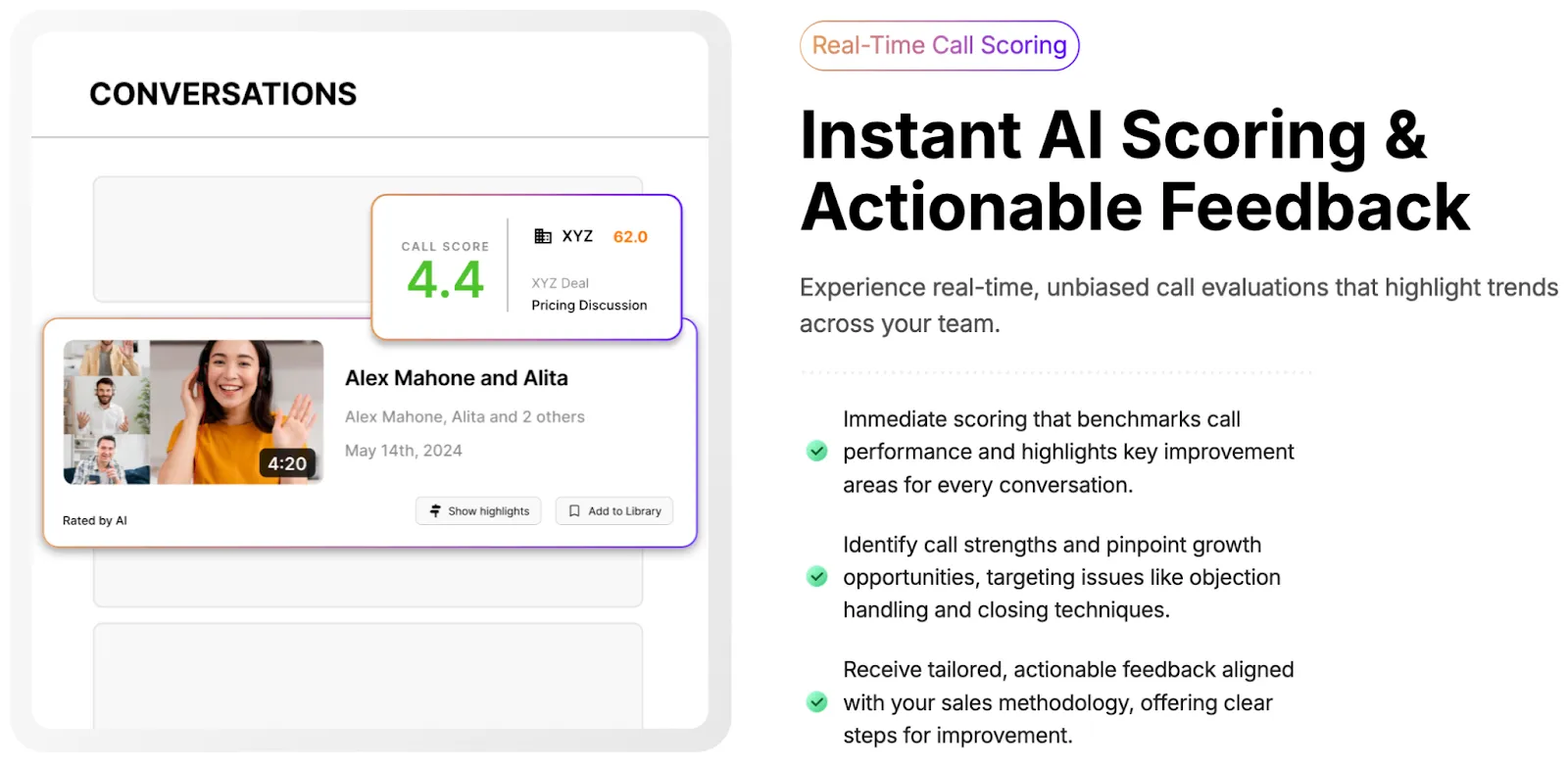
Key Features:
Pricing:
Custom pricing based on your team size and feature needs. Book a demo to learn more.
Ideal For:
Sales teams focused on coaching, not just call review.
Testimonial:
Aisha M., SDR, from G2 reviews
G2 Rating: 4.6/5
2. Gong
Gong offers deep call analytics, conversation trends, and sales activity tracking. Its real-time capabilities include call alerts and trackers that flag key deal moments, though most coaching still happens post-call.
Enterprise sales orgs use Gong for analyzing patterns across deals and teams rather than coaching live reps directly during calls.
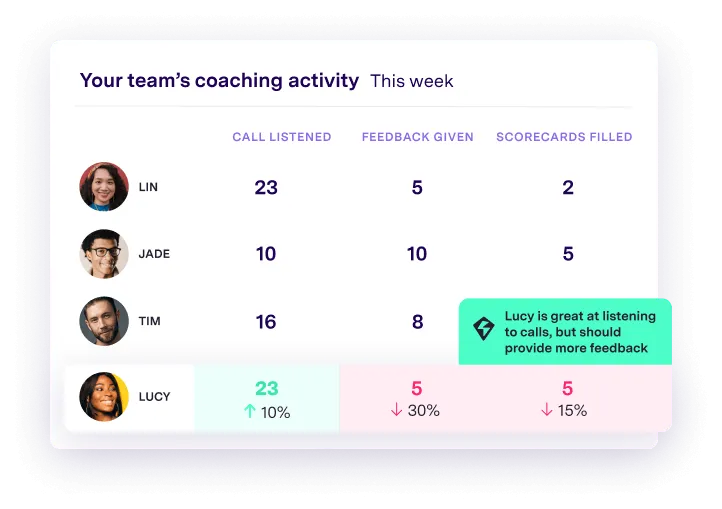
Key Features:
Pricing:
Not listed publicly; typically priced in the five-figure range for the full suite.
Ideal For:
Revenue teams looking for revenue intelligence, pipeline visibility, and advanced analytics.
Testimonial:
Arbenita B., Sales Development Manager, from G2 reviews
G2 Rating: 4.8/5
3. Chorus by ZoomInfo
Chorus, now under ZoomInfo, focuses on post-call analysis but has started introducing real-time insights. It captures conversations, flags keywords, and helps managers coach reps using conversation libraries.
Its strength lies in tying conversations to broader pipeline intelligence.
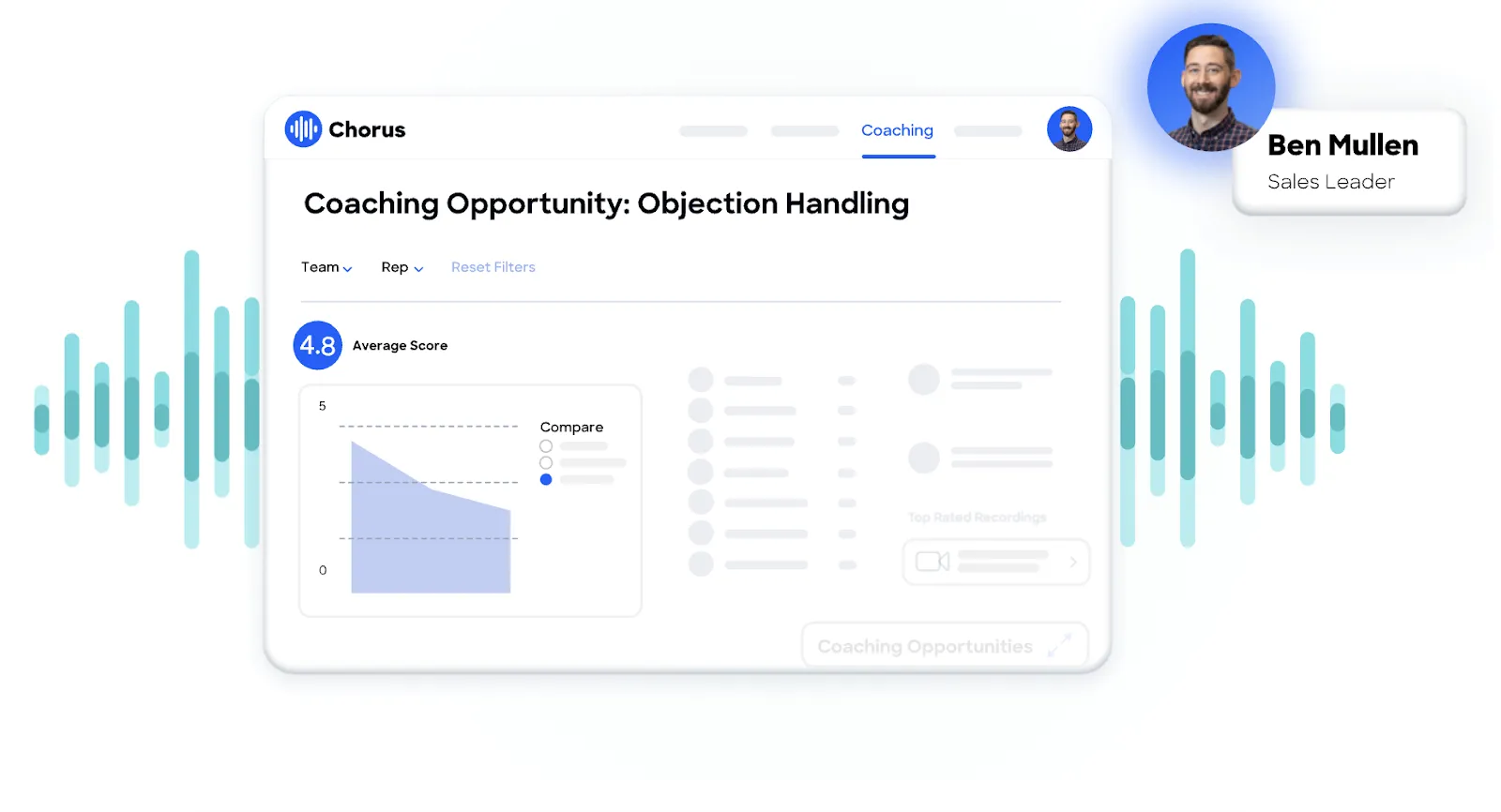
Key Features:
Pricing:
Not listed publicly.
Ideal For:
Sales orgs already using ZoomInfo and focused on insights over real-time nudges.
Testimonial:
Chelsea K., Customer Success Manager, from G2 reviews
G2 Rating: 4.5/5
4. Mindtickle
Mindtickle specializes in sales readiness and rep enablement. Its real-time capabilities come from integration with call platforms where it pushes micro-coaching prompts.
It shines in structured rep onboarding, certification, and skill-building programs tied to business outcomes.
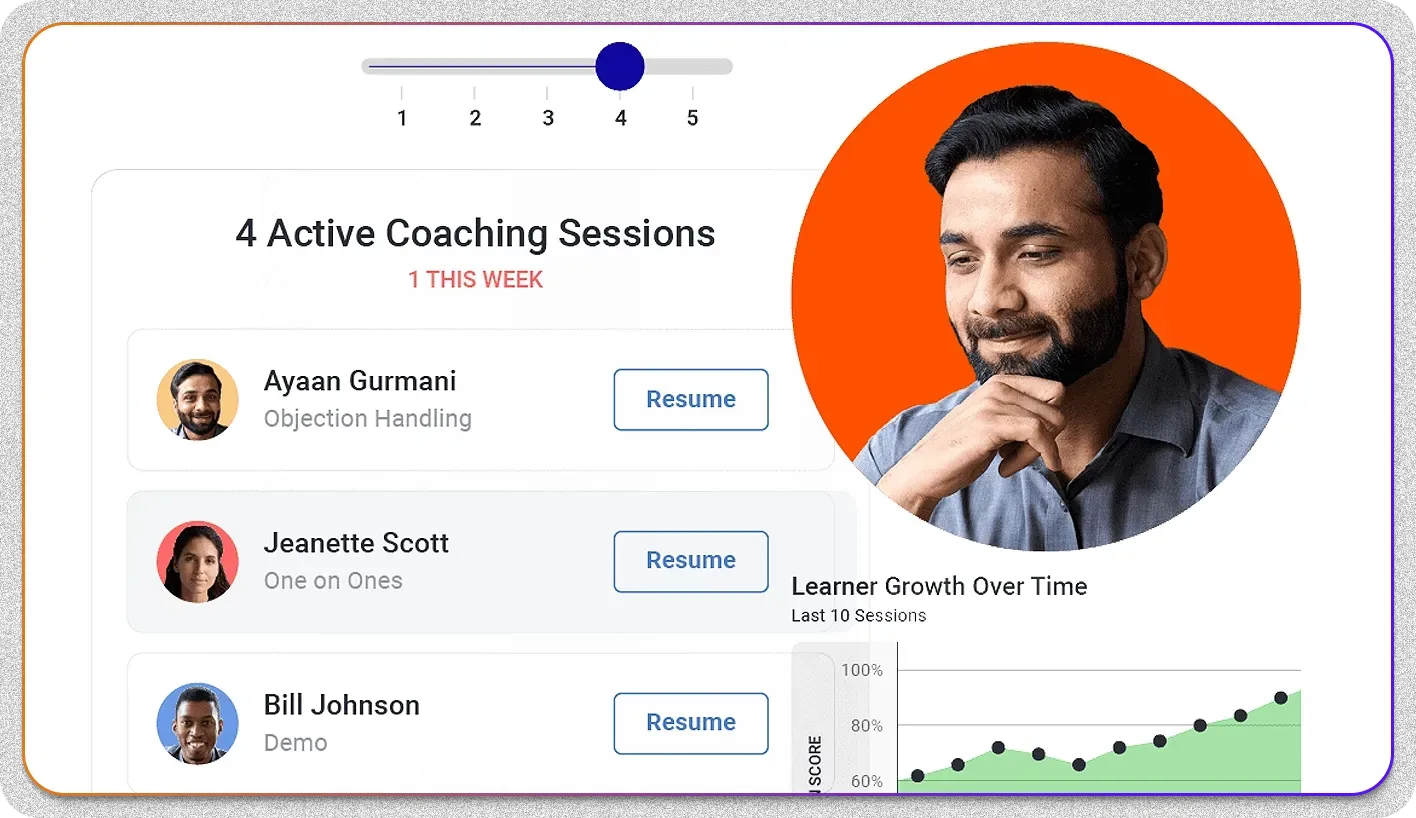
Key Features:
Pricing:
Not listed publicly
Ideal For:
Large teams with formal enablement programs and complex onboarding needs.
Testimonial:
Brent D., from G2 reviews
G2 Rating: 4.7/5
5. SalesHood
SalesHood combines content sharing, peer coaching, and structured learning into one platform. It includes call coaching, manager feedback workflows, and real-time learning moments.
While not as real-time as MeetRecord, it allows in-call learning by integrating with CRM and call platforms.
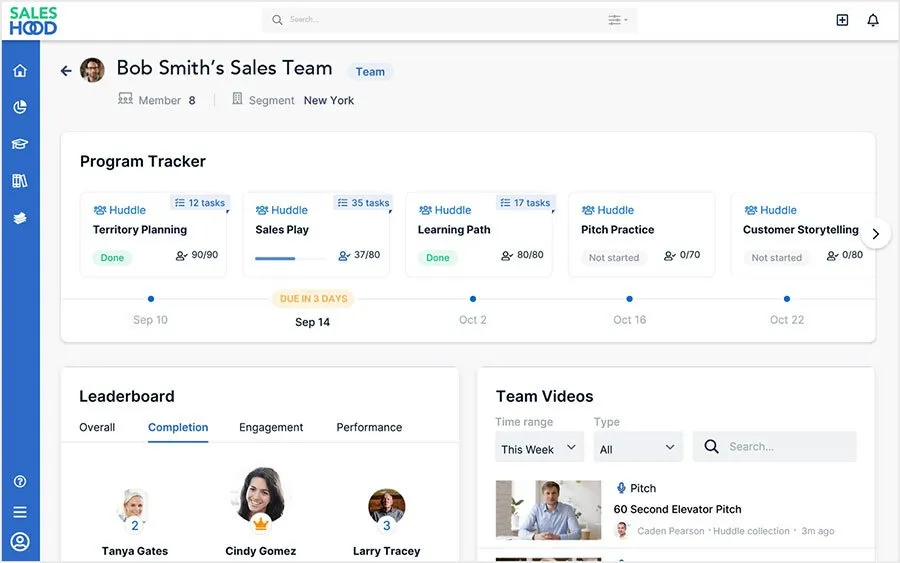
Key Features:
Pricing:
Starts at $45/user/month.
Ideal For:
Enablement-led sales orgs looking to scale coaching culture.
Testimonial:
Jaskaran S., Global Director of Sales Enablement, from G2 reviews
G2 Rating: 4.6/5
6. Avoma
Avoma offers call recording, note-taking, and coaching summaries. It provides mid-call alerts, talk-time metrics, and follow-up recommendations.
While strong on automation and notes, its real-time capabilities are more limited compared to platforms purpose-built for live coaching.
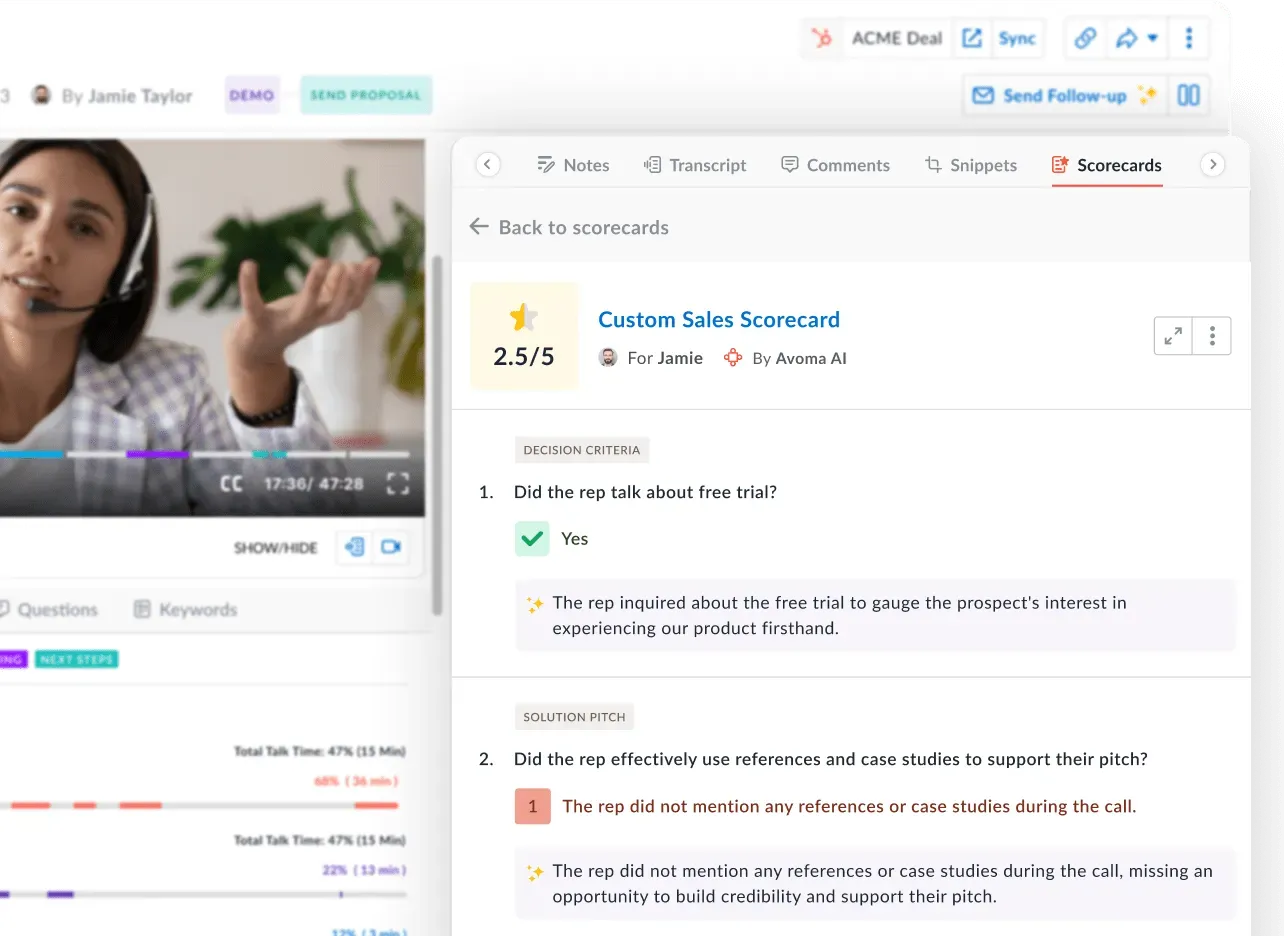
Key Features:
Pricing:
Free plan available. Paid plans start at $19 per "recorder" seat per month.
Ideal For:
Small sales teams looking for affordable coaching automation.
Testimonial:
Anonymous user, from G2 reviews
G2 Rating: 4.6/5
7. Refract (by Allego)
Refract helps teams analyze sales conversations and provides manager-reviewed coaching clips. It also includes roleplay and simulation capabilities.
While not natively real-time, it supports scenario-based practice that helps reps prepare for live calls.
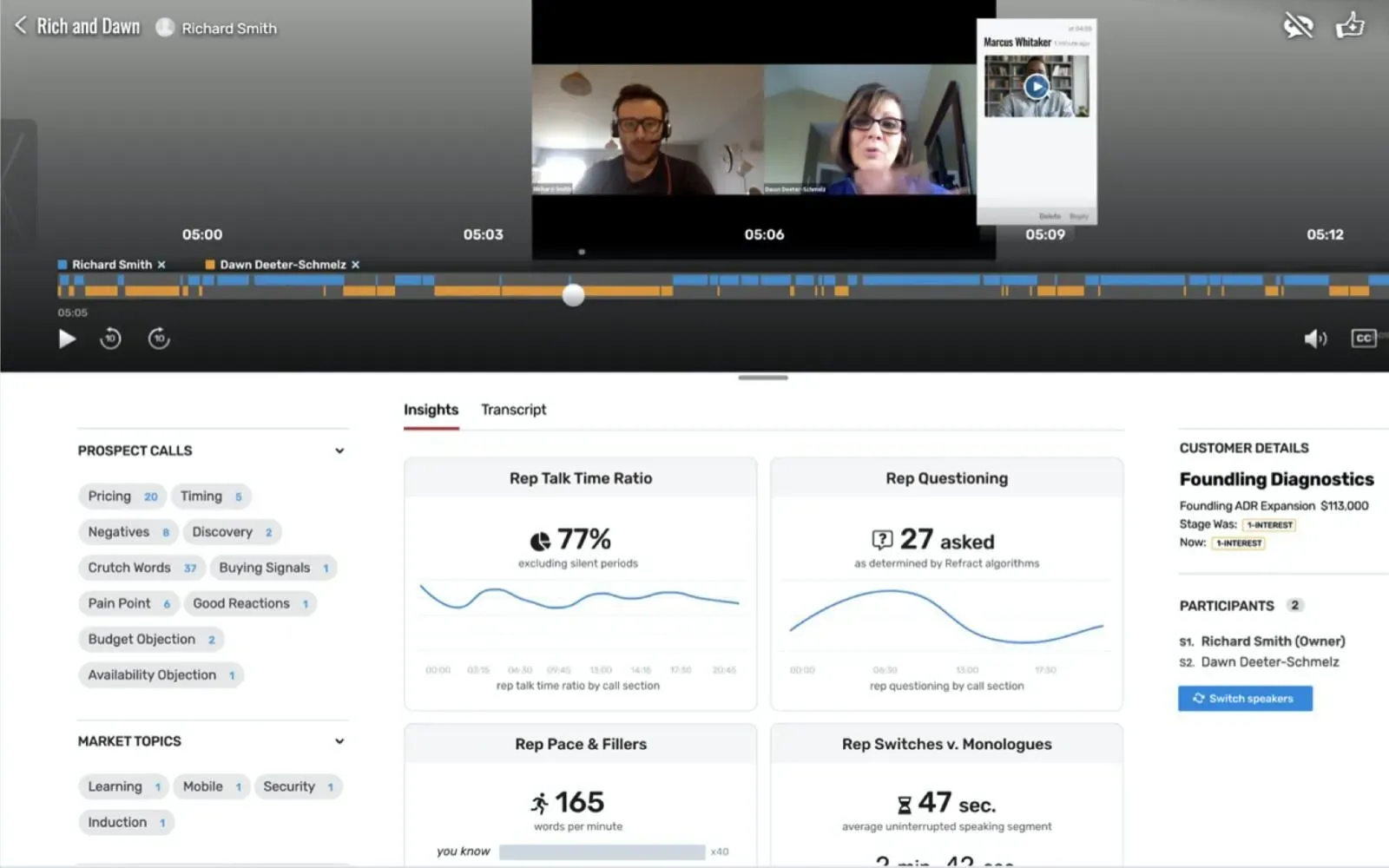
Key Features:
Pricing:
Not listed publicly.
Ideal For:
Organizations that prioritize recorded call coaching and roleplay development.
Testimonial:
Ferne E., CRS, from G2 reviews
G2 Rating: 4.6/5
8. ExecVision (Now Mediafly)
ExecVision, now part of Mediafly, is built for teams that take coaching seriously. The platform centers on human-led, manager-driven coaching, rather than full AI automation.
What makes ExecVision stand out is its focus on coaching accountability. Managers can track who’s reviewing calls, leaving feedback, and actually following through.
Scorecards, annotations, and call libraries help reinforce specific skills, while comparison dashboards give leaders visibility into performance trends across reps.
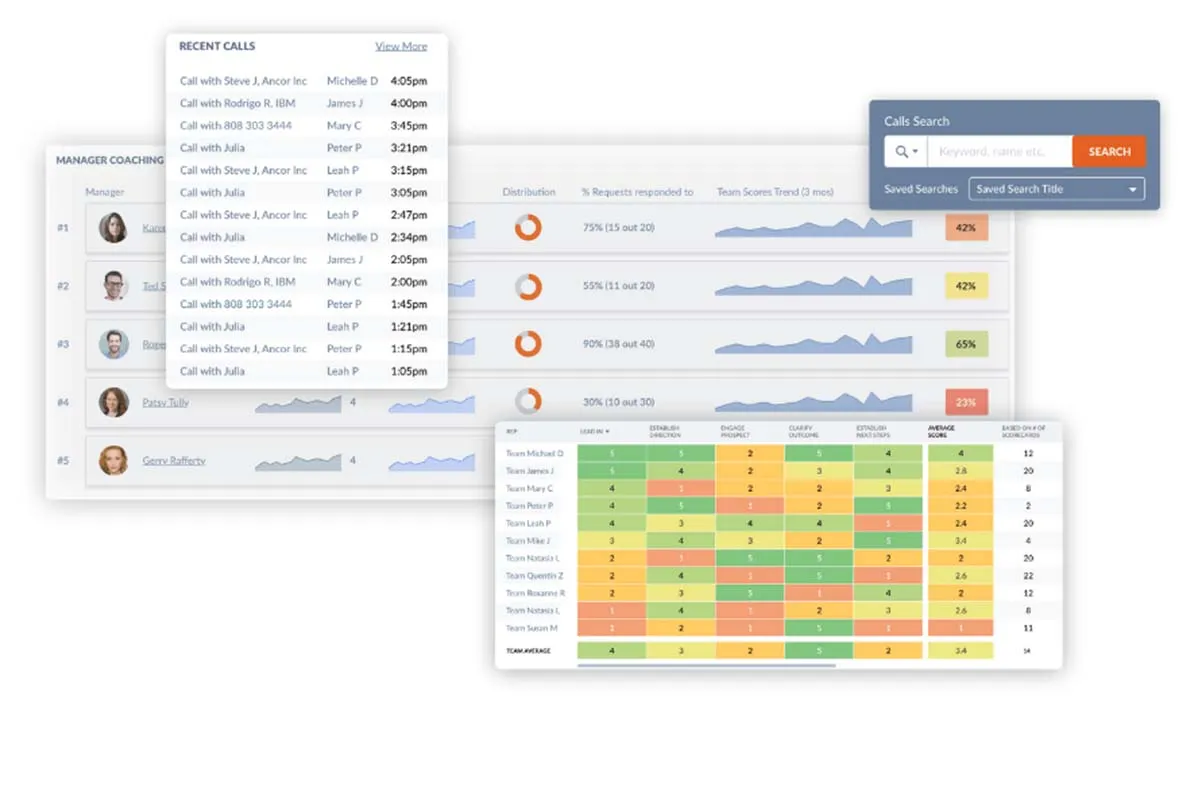
Key Features:
Pricing:
Not listed publicly.
Ideal For:
Teams that want structured, manager-led coaching workflows without relying on real-time AI prompts.
Testimonial:
Matt S., Enterprise user, from G2 reviews
G2 Rating: 4.4/5
9. Second Nature
Second Nature uses AI avatars to simulate sales calls and roleplay scenarios. It's a coaching-first platform built for reps to practice in a low-risk environment.
While it doesn’t coach on live calls, it helps build muscle memory ahead of key meetings.
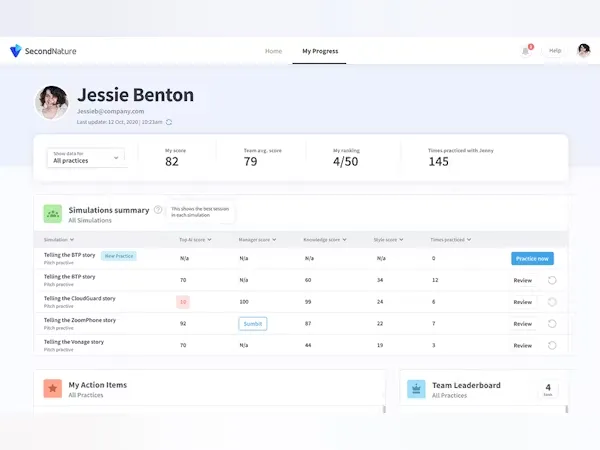
Key Features:
Pricing:
Not listed publicly.
Ideal For:
Teams that want reps to practice before getting on real calls.
Testimonial:
Esther M., Assistant Store Manager, from G2 reviews
G2 Rating: 4.6/5
10. Brainshark
Brainshark is now rebranded as Bigtincan. It’s primarily a sales enablement tool with video coaching, onboarding, and rep readiness assessments.
It doesn’t offer real-time call coaching but provides scalable coaching through video assignments and learning paths.
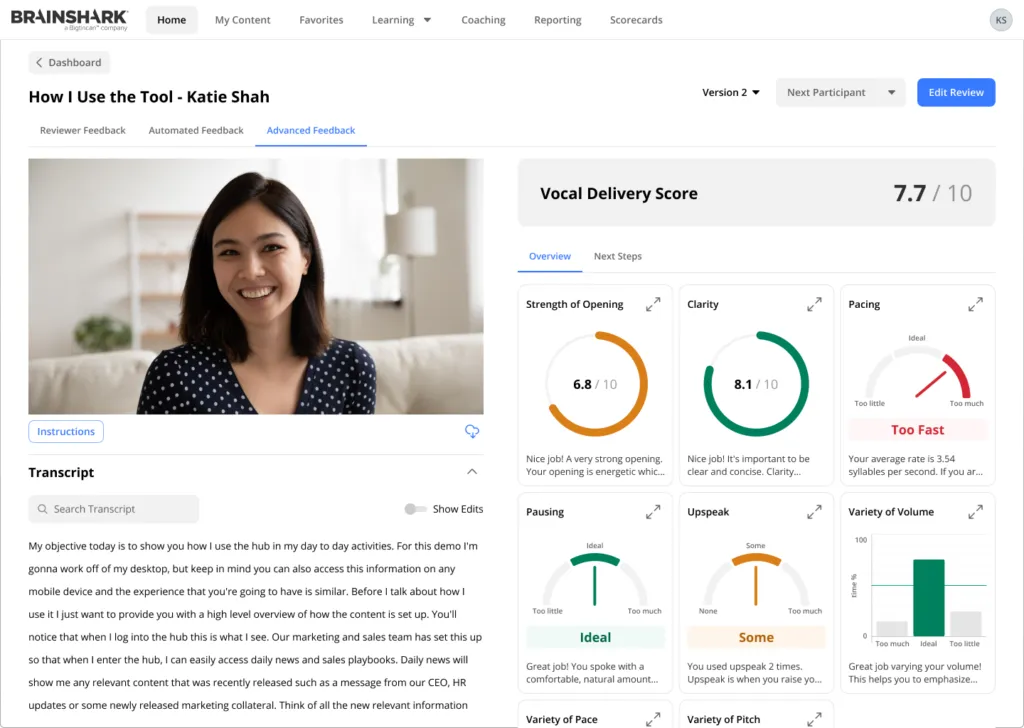
Key Features:
Pricing:
Not listed publicly.
Ideal For:
Enterprises that prioritize video coaching and compliance-driven enablement.
Testimonial:
Mary B., Sales Enablement and Strategy Professional, from G2 reviews
G2 Rating: 4.4/5
Here’s a quick comparison table to help you pick the real-time coaching tool that actually fits your team:
AI Sales Coaching vs Sales Training: What’s the Difference?
Sales training and sales coaching are often used interchangeably, but they serve very different purposes.
Sales training is a time-bound event that often happens during onboarding, quarterly sessions, or product launches. It’s usually one-time or scheduled learning.
Sales coaching is continuous, contextual, and based on a rep’s actual sales performance. Coaching adjusts with a rep’s performance, while training is a one-size-fits-all format.
With the advancement in AI, the lines between the two have started to blur, and for a good reason. It just means your tech stack should support both.
AI sales coaching tools give reps live feedback during conversations. They listen to calls, flag risky moments, and recommend actions that could change the outcome right there.
Features like AI-powered call scoring, objection handling prompts, and talk-time analysis help reps course-correct on the fly.
AI sales training platforms, on the other hand, simulate real-world scenarios before the call. Think AI roleplay, rep scorecards, and gamified leaderboards.
These tools help reps sharpen their pitch, handle objections, and get feedback from virtual personas or managers before they talk to real buyers.
Some platforms, like MeetRecord, offer the best of both worlds. MeetRecord lets reps practice through AI simulations, track progress via scorecards, and apply the learnings during live calls.
What are the Emerging Trends in Sales Coaching Platforms?
Sales coaching software isn’t limited to recording calls or flagging filler words. The category is evolving fast into a performance engine powered by AI and measured against real revenue outcomes.
Here are the biggest trends shaping where it’s going next.
1. AI is the New Sales Copilot
Sales coaching platforms were known to be reactive. But AI is reinventing them to become a real-time sales assistant.
Instead of just analyzing calls after they end, modern tools now coach reps while they’re in the thick of it.
This leads to faster ramp time, fewer missed signals, smarter decisions, and better call outcomes.
2. Coaching is Now Personal at Scale
One-size-fits-all coaching doesn’t work. Reps have different strengths, weaknesses, and learning curves. The new era of coaching software gets this.
For instance, AI-powered systems can now track individual rep performance and tailor coaching plans to their unique gaps.
If a rep consistently skips budget discussions, they’ll get feedback specific to that behavior. Another rep might get coaching on improving their talk-to-listen ratio.
This level of personalization used to require a coach for every rep. Now, software can do it automatically and without any bias.
3. Voice and Sentiment Analysis is Gaining Ground
Buyers don’t just speak, they signal through non-verbal cues. Tone, hesitation, and voice inflection often reveal more than words.
Sales coaching platforms are beginning to pick up on those layers.
Some tools now offer sentiment and speech analysis to detect emotional cues, like when a buyer sounds confused, skeptical, or disengaged.
These cues, when layered with talk-time data and objection triggers, help reps recognize red flags in the moment.
If your rep misreads tone, they can easily rush the close, push too soon, or talk past a no. But a tool that can spot these subtle cues early can help reps build trust and win deals.
4. Leaderboards Are Getting Smarter
Leaderboards used to be basic: top call volumes, most closed deals, shortest talk times. But today’s coaching platforms are making them more meaningful.
Now, leaderboards factor in skill growth, call quality, and coaching milestones. Tools don’t rank reps based on vanity metrics. They’re ranked based on how they handle objections, run discovery calls, or carry out multi-threaded conversations.
Some coaching tools even gamify roleplay practice, peer reviews, and call scoring accuracy to drive competition. When reps see how their progress stacks up against peers, they’re more likely to stay committed and sharp.
Real-Time Coaching Is the Difference Between Hitting and Missing Quota
Sales coaching isn’t a “nice-to-have” anymore. It’s a performance multiplier hiding in plain sight. Real-time coaching gives your reps the one thing most tools can’t: timing.
It offers feedback before the deal slips, nudges that appear right when you're talking to the buyers, and context that helps even average reps make better decisions under pressure.
But not every platform can deliver that kind of impact. Some tools are great for recording calls. Others are built for peer training or onboarding workflows. What you need is a tool that works where your team actually sells: live, inside the deal, not after it’s gone cold.
MeetRecord was built with that in mind. It helps sales teams coach in real time, simulate tough conversations with AI roleplays, and tie rep behaviors directly to revenue movement. It’s not just call tracking. It’s a coaching engine designed for quota-carrying teams.
key
If you’re ready to see how real-time sales coaching could work for your org, book a quick demo. You’ll see how you can coach your team instantaneously, not weeks later when it’s already too late.


.svg)

.webp)



